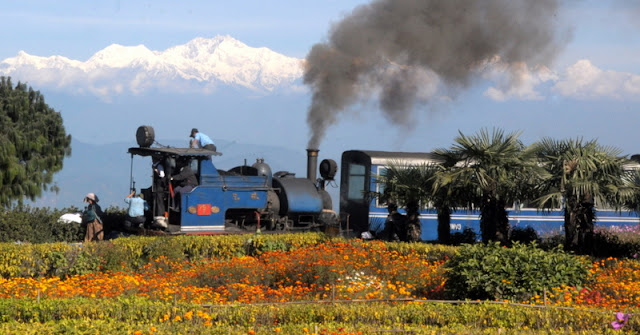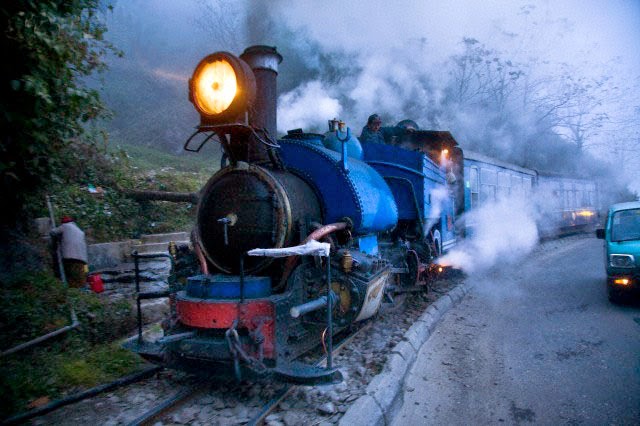A toy train carrying more than 50 tourists hurtled down sloping rail tracks in Kurseong yesterday as its wheels skidded, causing the death of a Calcutta lady who may have fallen off.
The alertness of a Siliguri-based businessman saved lives in the three coaches. Giridharilal Gan, a bookseller from Siliguri, turned the wheel-like emergency brake - each coach has one - as the guard on duty on the train had jumped off like several passengers had.
%2BThe%2Btoy%2Btrain%2Bat%2Bthe%2Baccident%2Bspot%3B%2BGiridharilal%2BGan%2B(above)%2C%2Bthe%2Bbookseller%2Bfrom%2BSiliguri%2Bwhose%2Bpresence%2Bof%2Bmind%2Bsaved%2Bco-passengers.%2BPicture%2Bby%2BSuman%2BTamang.jpg) |
(Bottom left) The toy train at the accident spot; Giridharilal Gan (above), the bookseller from
Siliguri whose presence of mind saved co-passengers. Picture by Suman Tamang |
Tourists today spoke of the horrifying "death-train-like" experience as they saw a co-passenger leaping out with a kid in her arms.
According to co-passengers, Beliaghata's Moly Pal, 51, jumped, too, but did not survive. Her brother, however, said Moly may have fallen off.
When the 57 tourists started the Jungle Safari ride from Siliguri Junction at 10.35am on Republic Day, the train was late by 35 minutes.
The to-and-fro ride from Siliguri to Gayabari in Kurseong subdivision, snaking through the Mahananda wildlife park and with a 15-minute halt before return, takes five-and-a-half hours. Tourists embarking at 10am can expect to be back in Siliguri around 3.30pm.
But as the train started late yesterday, the operators said they would not go the whole stretch up to Gayabari - 35km from Siliguri Junction - but till Tindharia, which is 30km from Siliguri. As a consolation to the tourists, the driver said there would be a stop for about an hour at Tindharia, so tourists can go to nearby shops.
Toy trains rarely move at a speed more than 20kmph, making them inconvenient for long rides or daily commute.
The train reached Tindharia at 12.45pm and started for Siliguri at 1.45pm.
Gan said: "I was in a group of 24 people and we were in the last of the three coaches. As the train was moving downhill, it seemed to have picked up speed. Then we saw a person jump off and realised something must be wrong," Gan said. "Soon, the guard, who was in our coach, also leapt out."
Seeing the guard jump off, some of the women passengers panicked and started crying. "The doors and windows were rattling. People were yelling," Gan said.
By then, some passengers had started shouting that the brakes had failed - the railways did not agree with this theory, though an official said the wheels slipped on the tracks despite the application of the brakes.
Gan said he knew there was a wheel-like emergency brake at the rear of every coach as "I have travelled in toy train several times before". "I ran to the back of the coach. I rotated the brake wheel thrice. Nothing happened, the train was still hurtling down. When I rotated the wheel the fourth time, it screeched to a halt after couple of minutes," he said.
The train came to a halt near Chunabhatti station, which is a couple of kilometres from Tindharia.
"This entire thing happened in five to seven minutes, but the experience was horrifying. Either the train would have gone off the tracks and fallen into a gorge ahead or it would have rammed into homes and shops at the side of the tracks and killed more people," the 44-year-old, who has a bookshop in Siliguri's Collegepara, said.
After the train stopped, local people helped the passengers disembark.
The driver, Gan said, was still in the engine room. "He said there had been a technical problem and that he had no way of stopping the train other than applying the emergency brake which I had done."
Nikita Saha, a Siliguri-based dentist on the train with her eight-year-old daughter Neha, said the morning "joy ride became a death ride".
She said: "Some passengers were jumping off. A lady who did that lost her life, it was horrifying." The "quick action of this gentleman (Gan) saved all of us who did not jump off," Nikita said.
Kartik Das, another Siliguri resident, said he saw "a woman jump from the first coach. Within seconds, another woman carrying a child in her lap, followed."
He said when the train stopped "we ran uphill along the tracks to locate those who had jumped off. We found the woman, who had jumped first, lying near the tracks, unconscious. The woman who had jumped after her with her child had suffered injuries but both were conscious. We called up the police."
The lady who had fallen off or jumped first was 51-year-old Moly Pal of Beliaghata.
Eyewitnesses said Moly had rammed against the wall of a house when she fell. But her brother said Moly's family on the train saw her chin hit the locomotive as she fell.
The ordeal for the passengers did not end with the ride. "There was no railway official to help us reach Siliguri. Each of us had to call for vehicles from Siliguri and we returned home in the evening," Nikita said.
A police officer later said three people suffered injuries when they jumped off.
"A woman died and three others got injured. The post-mortem was conducted at NBMCH today and her body was sent to Calcutta with her relatives," the police officer of Kurseong subdivision said.
When asked what snag led to the accident, a railway official said the wheels slipped on the tracks after the brake was applied. He refused to call it a failure of the braking system.
"There was some slipping of wheels on the tracks when the train was travelling downhill. This happens when brakes are applied forcefully in a moving train.... An inquiry committee will investigate the incident," said A.K. Sharma, the divisional manager (Katihar division) of the Northeast Frontier Railway.
Asked whether any action would be taken against the guard who had jumped off instead of operating the emergency brake, Sharma said: "I have got the information and referred it to the inquiry committee. If found guilty, we will definitely take necessary action against the guard".
Moly's family said her husband and four relatives were on the train.
"They were coming back to Siliguri. The train was coming down from the mountains at a very high speed unusual for a toy train," said Sumitava Pal, Moly's brother who stays at Siliguri. "It is not clear whether my sister tried to jump off or she fell down," he said.
Gan today said: "It's like I escaped death."
Source: Telegraph






%2BThe%2Btoy%2Btrain%2Bat%2Bthe%2Baccident%2Bspot%3B%2BGiridharilal%2BGan%2B(above)%2C%2Bthe%2Bbookseller%2Bfrom%2BSiliguri%2Bwhose%2Bpresence%2Bof%2Bmind%2Bsaved%2Bco-passengers.%2BPicture%2Bby%2BSuman%2BTamang.jpg)



+Avinash+Gurung+at+the+Gorkha+Rangamanch+Bhavan+in+Darjeeling+on+Saturday;+Bimal+and+Asha+Gurung+in+the+audience.+Pictures+by+Suman+Tamang.jpg)


